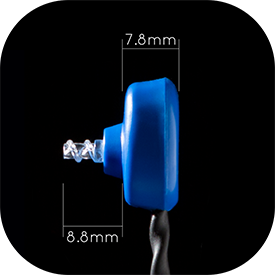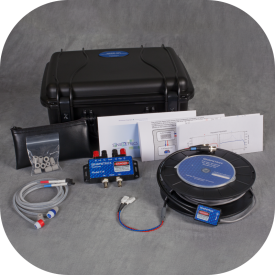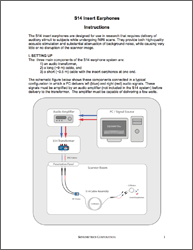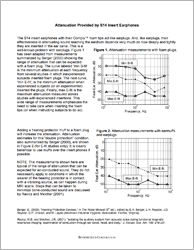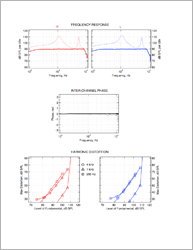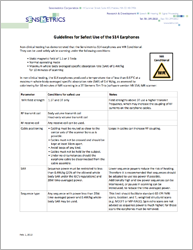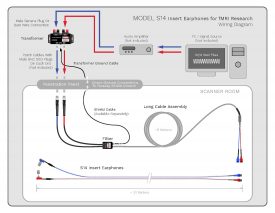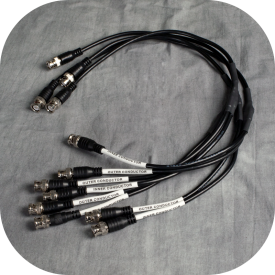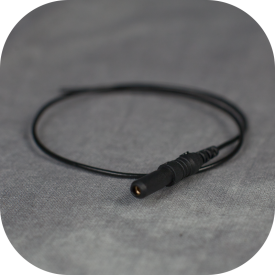Published studies using Sensimetrics insert earphones for fMRI research:
Processing pathways for emotional vocalizations
Tiffany Grisendi, Olivier Reynaud, Stephanie Clarke, Sandra Da Costa
Brain Structure and Function – July 6, 2019, pp 1–18
https://doi.org/10.1007/s00429-019-01912-x
Language learning experience and mastering the challenges of perceiving speech in noise
Shanna Kousaie, Shari Baumb, Natalie A. Phillips, Vincent Gracco, Debra Titon, Jen-Kai Chen, Xiaoqian J. Chai, Denise Klein
Brain and Language – Volume 196, September 2019, 104645
https://doi.org/10.1016/j.bandl.2019.104645
Divergence in the functional organization of human and macaque auditory cortex revealed by fMRI responses to harmonic tones
Sam V. Norman-Haignere, Nancy Kanwisher, Josh H. McDermott, Bevil R. Conway
Nature Neuroscience – Volume 22, pages 1057–1060, June 10, 2019
https://doi.org/10.1038/s41593-019-0410-7
Early Blindness Shapes Cortical Representations of Auditory Frequency within Auditory Cortex
Elizabeth Huber, Kelly Chang, Ivan Alvarez, Aaron Hundle, Holly Bridge, Ione Fine
Journal of Neuroscience – Vol. 39, Issue 26, 26 Jun 2019
https://doi.org/10.1523/JNEUROSCI.2896-18.2019
Processing complexity increases in superficial layers of human primary auditory cortex
Michelle Moerel, Federico De Martino, Kâmil Uğurbil, Essa Yacoub, Elia Formisano
Nature – Scientific Reports – Volume 9, Article number: 5502 (2019)
https://doi.org/10.1038/s41598-019-41965-w
Brain activity during reciprocal social interaction investigated using conversational robots as control condition
Birgit Rauchbauer, Bruno Nazarian, Morgane Bourhis, Magalie Ochs, Laurent Prévot, Thierry Chaminade
The Royal Society – March 11, 2019, Volume 374, Issue 1771
https://doi.org/10.1098/rstb.2018.0033
Musical reward prediction errors engage the nucleus accumbens and motivate learning
Benjamin P. Gold, Ernest Mas-Herrero, Yashar Zeighami, Mitchel Benovoy, Alain Dagher, Robert J. Zatorre
PNAS February 19, 2019 116 (8) 3310-3315
https://doi.org/10.1073/pnas.1809855116
Separable neural representations of sound sources: Speaker identity and musical timbre
Mattson Ogg, Dustin Moraczewski, Stefanie E. Kuchinsky, L. Robert Slevc
NeuroImage – Volume 191, 1 May 2019, Pages 116-126
https://doi.org/10.1016/j.neuroimage.2019.01.075
Partially Overlapping Brain Networks for Singing and Cello Playing
Melanie Segado, Avrum Hollinger, Joseph Thibodeau, Virginia Penhune, Robert J. Zatorre
Frontiers in Neuroscience, 28 May 2018
https://doi.org/10.3389/fnins.2018.00351
Functionally distinct language and Theory of Mind networks are synchronized at rest and during language comprehension
Alexander M. Paunov, Idan A. Blank, Evelina Fedorenko
Journal of Neurophysiology – March 29, 2019
https://doi.org/10.1152/jn.00619.2018
The impact of spelling regularity on handwriting production: A coupled fMRI and kinematics study
Sarah Palmis, Jean-LucVelay, Elie Fabiani, Bruno Nazarian, Jean-Luc Anton, Michel Habib, Sonia Kandel, Marieke Longcamp
Cortex – Volume 113, April 2019, Pages 111-127
https://doi.org/10.1016/j.cortex.2018.11.024
Young children’s neural processing of their mother’s voice: An fMRI study
Pan Liu, Pamela M. Cole, Rick O. Gilmore, Koraly E. Pérez-Edgar, Michelle C. Vigeant, Peter Moriarty, K. Suzanne Scherfa
Neuropsychologia – Volume 122, January 2019, Pages 11-19
https://doi.org/10.1016/j.neuropsychologia.2018.12.003
Hierarchy of speech-driven spectrotemporal receptive fields in human auditory cortex
Jonathan H. Venezia, Steven M. Thurman, Virginia M. Richards, Gregory Hickok
NeuroImage – Volume 186, 1 February 2019, Pages 647-666
https://doi.org/10.1016/j.neuroimage.2018.11.049
Interaction of the effects associated with auditory-motor integration and attention-engaging listening tasks
Patrik Wikman, Teemu Rinne
Social Cognitive and Affective Neuroscience, Volume 13, Issue 12, December 2018, Pages 1293–1304
https://doi.org/10.1016/j.neuropsychologia.2018.11.006
A drama movie activates brains of holistic and analytical thinkers differentially
Mareike Bacha-Trams, Yuri I Alexandrov, Emilia Broman, Enrico Glerean, Minna Kauppila, Janne Kauttonen, Elisa Ryyppö, Mikko Sams, Iiro P Jääskeläinen
Social Cognitive and Affective Neuroscience, Volume 13, Issue 12, December 2018, Pages 1293–1304
https://doi.org/10.1093/scan/nsy099
Reduced auditory cortical adaptation in autism spectrum disorder
Rachel Millin, Tamar Kolodny, Anastasia V Flevaris, Alexander M Kale, Michael-Paul Schallmo, Jennifer Gerdts, Raphael A Bernier, Scott Murray
eLife Sciences – 26 October 2018
https://doi.org/10.7554/eLife.36493
Feature-dependent intrinsic functional connectivity across cortical depths in the human auditory cortex
Pu-Yeh Wu, Ying-Hua Chu, Jo-Fu Lotus Lin, Wen-Jui Kuo, Fa-Hsuan Lin
Nature: Scientific Reports – Volume 8, Article number: 13287 September 5, 2018
https://doi.org/10.1038/s41598-018-31292-x
Reduced sound-evoked and resting-state BOLD fMRI connectivity in tinnitus
Benedikt Hofmeier, Stephan Wolpert, Ebrahim Saad Aldamer, Moritz Walter, John Thiericke, Christoph Braun, Dennis Zelle, Lukas Rüttiger, Uwe Klose, Marlies Knipper
NeuroImage: Clinical – Volume 20, 2018, Pages 637-649
https://doi.org/10.1016/j.nicl.2018.08.029
Active Sound Localization Sharpens Spatial Tuning in Human Primary Auditory Cortex
Kiki van der Heijden, Josef P. Rauschecker, Elia Formisano, Giancarlo Valente, Beatrice de Gelder
Journal of Neuroscience – 3 October 2018, 38 (40) 8574-8587
https://doi.org/10.1523/JNEUROSCI.0587-18.2018
Singing in the brain: Neural representation of music and voice as revealed by fMRI
Jocelyne C. Whitehead, Jorge L. Armony
Human Brain Mapping – Volume39, Issue12 – December 2018, Pages 4913-4924
https://doi.org/10.1002/hbm.24333
Functional connectivity within the voice perception network and its behavioural relevance
Virginia Aglieri, Thierry Chaminade, Sylvain Takerkart, Pascal Belin
NeuroImage – Volume 183, December 2018, Pages 356-365
https://doi.org/10.1016/j.neuroimage.2018.08.011
Free viewing of talking faces reveals mouth and eye preferring regions of the human superior temporal sulcus
Johannes Rennig, Michael S. Beauchamp
NeuroImage – Volume 183, December 2018, Pages 25-36
https://doi.org/10.1016/j.neuroimage.2018.08.008
Listening for memories: Attentional focus dissociates functional brain networks engaged by memory-evoking music
Benjamin Kubit, Petr Janata
Psychomusicology: Music, Mind, and Brain, 28(2), 82-100
http://dx.doi.org/10.1037/pmu0000210
Neural specialization of phonological and semantic processing in young children
Yael Weiss, Hannah G. Cweigenberg, James R. Booth
Human Brain Mapping – June 28, 2018
https://doi.org/10.1002/hbm.24274
Hearing and orally mimicking different acoustic-semantic categories of natural sound engage distinct left hemisphere cortical regions
James W. Lewis, Magenta J. Silberman, Jeremy J. Donai, Chris A. Frum, Julie A. Brefczynski-Lewis
Brain and Language – Volume 183, August 2018, Pages 64-78
https://doi.org/10.1016/j.bandl.2018.05.002
Neural Prediction Errors Distinguish Perception and Misperception of Speech
Helen Blank, Marlene Spangenberg, Matthew H. Davis
Journal of Neuroscience – 4 July 2018, 38 (27) 6076-6089
https://doi.org/10.1523/JNEUROSCI.3258-17.2018
Neural network retuning and neural predictors of learning success associated with cello training
Indiana Wollman, Virginia Penhune, Melanie Segado, Thibaut Carpentier, Robert J. Zatorre
PNAS – June 26, 2018 115 (26) E6056-E6064
https://doi.org/10.1073/pnas.1721414115
Neural representation of vowel formants in tonotopic auditory cortex
Julia M. Fisher, Frederic K. Dick, Deborah F. Levy, Stephen M. Wilson
Annals of The New York Academy of Sciences – May 9, 2018
https://doi.org/10.1016/j.neuroimage.2018.05.072
Cross‐classification of musical and vocal emotions in the auditory cortex
Sébastien Paquette, Sylvain Takerkart, Shinji Saget, Isabelle Peretz, Pascal Belin
Annals of The New York Academy of Sciences – May 9, 2018
https://doi.org/10.1111/nyas.13666
Exploring collective experience in watching dance through intersubject correlation and functional connectivity of fMRI brain activity
Frank E. Pollick, Staci Vicary, Katie Noble, Naree Kim, Seonhee Jang, Catherine J. Stevens
Progress in Brain Research – Volume 237, 2018, Pages 373-397
https://doi.org/10.1016/bs.pbr.2018.03.016
A Task-Optimized Neural Network Replicates Human Auditory Behavior, Predicts Brain Responses, and Reveals a Cortical Processing Hierarchy
Alexander J.E. Kell, Daniel L.K. Yamins, Erica N. Shook, Sam V. Norman-Haignere, Josh H. McDermott
Neuron – Volume 98, Issue 3, 2 May 2018, Pages 630-644.e16
https://doi.org/10.1016/j.neuron.2018.03.044
Distributed affective space represents multiple emotion categories across the human brain
Heini Saarimaki, Lara Farzaneh Ejtehadian, Enrico Glerean, Iiro P. Jaaskelainen, Patrik Vuilleumier, Mikko Sams, Lauri Nummenmaa
Social Cognitive and Affective Neuroscience, 2018, 471–482
https://doi.org/10.1093/scan/nsy018
Incongruent pitch cues are associated with increased activation and functional connectivity in the frontal areas
Jo-Fu Lotus Lin, Toshiaki Imada, Patricia K. Kuhl, Fa-Hsuan Lin
Nature Scientific Reports Volume 8, Article number: 5206 (2018)
https://doi.org/10.1038/s41598-018-23287-5
Sensorimotor Representation of Speech Perception – Cross-Decoding of Place of Articulation Features during Selective Attention to Syllables in 7T fMRI
Mario E. Archila-Meléndez, Giancarlo Valente, Joao Correia, Rob P. W. Rouhl, Vivianne H. van Kranen-Mastenbroek, Bernadette M. Jansma
eNeuro – March 22, 2018
https://doi.org/10.1523/ENEURO.0252-17.2018
Frequency-specific attentional modulation in human primary auditory cortex and midbrain
Lars Riecke, Judith C. Peters, Giancarlo Valente, Benedikt A. Poser, Valentin G. Kemper, Elia Formisano, Bettina Sorger
NeuroImage – Volume 174, 1 July 2018, Pages 274-287
https://doi.org/10.1016/j.neuroimage.2018.03.038
Acoustic and higher-level representations of naturalistic auditory scenes in human auditory and frontal cortex
Lars Hausfeld, Lars Riecke, Elia Formisano
NeuroImage – Volume 173, June 2018, Pages 472-483
https://doi.org/10.1016/j.neuroimage.2018.02.065
Inter-subject synchrony as an index of functional specialization in early childhood
Dustin Moraczewski, Gang Chen, Elizabeth Redcay
Nature – Scientific Reports Volume 8, Article number: 2252 (2018)
https://doi.org/10.1038/s41598-018-20600-0
Decoding auditory spatial and emotional information encoding using multivariate versus univariate techniques
James H. Kryklywy, Ewan A. Macpherson, Derek G. V. Mitchell
Experimental Brain Research – April 2018, Volume 236, Issue 4, pp 945–953
https://doi.org/10.1007/s00221-018-5185-7
Intrinsic, stimulus-driven and task-dependent connectivity in human auditory cortex
Suvi Häkkinen, Teemu Rinne
Brain Structure and Function – June 2018, Volume 223, Issue 5, pp 2113–2127
https://doi.org/10.1007/s00429-018-1612-6
Phase Entrainment of Brain Oscillations Causally Modulates Neural Responses to Intelligible Speech
Benedikt Zoefel, Alan Archer-Boyd, Matthew H. Davis
Current Biology – Volume 28, Issue 3, 5 February 2018, Pages 401-408.e5
https://doi.org/10.1016/j.cub.2017.11.071
Convergence of spoken and written language processing in the superior temporal sulcus
Stephen M. Wilson, Alexa Bautist, Angelica McCarron
NeuroImage – Volume 171, 1 May 2018, Pages 62-74
https://doi.org/10.1016/j.neuroimage.2017.12.068
Musical training sharpens and bonds ears and tongue to hear speech better
Yi Du, Robert J. Zatorre
PNAS – December 19, 2017 114 (51) 13579-13584
https://doi.org/10.1073/pnas.1712223114
Cortical networks for auditory detection with and without informational masking: Task effects and implications for conscious perception
Katrin Wiegand, Sabine Heiland, Christian H. Uhlig, Andrew R. Dykstra, Alexander Gutschalk
NeuroImage – Volume 167, 15 February 2018, Pages 178-190
https://doi.org/10.1016/j.neuroimage.2017.11.036
Reconstructing Tone Sequences from Functional Magnetic Resonance Imaging Blood-Oxygen Level Dependent Responses within Human Primary Auditory Cortex
Kelly H. Chang, Jessica M. Thomas, Geoffrey M. Boynton, Ione Fine
Frontiers In Psychology, 14 November 2017
https://doi.org/10.3389/fpsyg.2017.01983
Development of the Visual Word Form Area Requires Visual Experience: Evidence from Blind Braille Readers
Judy S. Kim, Shipra Kanjlia, Lotfi B. Merabet, Marina Bedny
Journal of Neuroscience 22 November 2017, 37 (47) 11495-11504
https://doi.org/10.1523/JNEUROSCI.0997-17.2017
Auditory Frequency Representations in Human Somatosensory Cortex
Alexis Pérez-Bellido, Kelly Anne Barnes, Lexi E Crommett, Jeffrey M Yau
Cerebral Cortex – Volume 28, Issue 11, November 2018, Pages 3908–3921
https://doi.org/10.1093/cercor/bhx255
Auditory Frequency Representations in Human Somatosensory Cortex
Alexis Pérez-Bellido, Kelly Anne Barnes, Lexi E Crommett, Jeffrey M Yau
Cerebral Cortex – Volume 28, Issue 11, November 2018, Pages 3908–3921
https://doi.org/10.1093/cercor/bhx255
Exploring the neural substrates of misinformation processing
Andrew Gordon, Jonathan C. W. Brooks, Susanne Quadflieg, Ullrich K.H. Ecker, Stephan Lewandowsky
Neuropsychologia – Volume 106, November 2017, Pages 216-224
https://doi.org/10.1016/j.neuropsychologia.2017.10.003
Reduced Laughter Contagion in Boys at Risk for Psychopathy
Elizabeth O’Nions, César F.Lima, Sophie K.Scott, Ruth Roberts, Eamon J. McCrory, Essi Viding
Current Biology – Volume 27, Issue 19, 9 October 2017, Pages 3049-3055.e4
https://doi.org/10.1016/j.cub.2017.08.062
High spatio‐temporal resolution in functional MRI with 3D echo planar imaging using cylindrical excitation and a CAIPIRINHA undersampling pattern
Wietske van der Zwaag, Olivier Reynaud, Mayur Narsude, Daniel Gallichan, José P. Marques
Magnetic Resonance In Medicine – September 14, 2017
https://doi.org/10.1002/mrm.26906
Cannabis Dampens the Effects of Music in Brain Regions Sensitive to Reward and Emotion
Tom P Freeman, Rebecca A Pope, Matthew B Wall, James A Bisby, Maartje Luijten, Chandni Hindocha, Claire Mokrysz, Will Lawn, Abigail Moss, Michael A P Bloomfield, Celia J A Morgan, David J Nutt, H Valerie Curran
International Journal of Neuropsychopharmacology, Volume 21, Issue 1, January 2018, Pages 21–32
https://doi.org/10.1093/ijnp/pyx082
Auditory Statistical Learning During Concurrent Physical Exercise and the Tolerance for Pitch, Tempo, and Rhythm Changes
Tatsuya Daikoku, Yuji Takahashi, Nagayoshi Tarumoto, Hideki Yasuda
Human Kinetics – Volume: 22 Issue: 3 Pages: 233-244
https://doi.org/10.1123/mc.2017-0006
Auditory Statistical Learning During Concurrent Physical Exercise and the Tolerance for Pitch, Tempo, and Rhythm Changes
Tatsuya Daikoku, Yuji Takahashi, Nagayoshi Tarumoto, Hideki Yasuda
Human Kinetics – Volume: 22 Issue: 3 Pages: 233-244
https://doi.org/10.1123/mc.2017-0006
Evidence for cue-independent spatial representation in the human auditory cortex during active listening
Nathan C. Higgins, Susan A. McLaughlin, Teemu Rinne, and G. Christopher Stecker
PNAS – August 21, 2017
https://doi.org/10.1073/pnas.1707522114
Amplification of local changes along the timescale processing hierarchy
Yaara Yeshurun, Mai Nguyen, and Uri Hasson
PNAS – August 15, 2017
https://doi.org/10.1073/pnas.1701652114
Sensory-Biased and Multiple-Demand Processing in Human Lateral Frontal Cortex
Abigail L. Noyce, Nishmar Cestero, Samantha W. Michalka, Barbara G. Shinn-Cunningham and David C. Somers
Journal of Neuroscience – September 6, 2017, 37 (36) 8755-8766
https://doi.org/10.1523/JNEUROSCI.0660-17.2017
Predictive processing increases intelligibility of acoustically distorted speech: Behavioral and neural correlates
Maria Hakonen, Patrick J. C. May, Iiro P. Jääskeläinen, Emma Jokinen, Mikko Sams, Hannu Tiitinen
Brain and Behavior – August 4, 2017
https://doi.org/10.1002/brb3.789
Subcortical and cortical correlates of pitch discrimination: Evidence for two levels of neuroplasticity in musicians
Federica Bianchi, Jens Hjortkjær, Sébastien Santurette, Robert J. Zatorre, Hartwig R. Siebner, Torsten Daua
NeuroImage – Volume 163, December 2017, Pages 398-412
https://doi.org/10.1016/j.neuroimage.2017.07.057
Functional brain outcomes of L2 speech learning emerge during sensorimotor transformation
Daniel Carey, Marc E. Miquel, Bronwen G. Evans, Patti Adank, Carolyn McGettigan
NeuroImage – Volume 159, 1 October 2017, Pages 18-31
https://doi.org/10.1016/j.neuroimage.2017.06.053
It doesn’t matter what you say: FMRI correlates of voice learning and recognition independent of speech content
Romi Zäske, Bashar Awwad Shiekh Hasan, Pascal Belin
Cortex – Volume 94, September 2017, Pages 100-112
https://doi.org/10.1016/j.cortex.2017.06.005
Adult-like processing of naturalistic sounds in auditory cortex by 3- and 9-month old infants
Conor J.Wild, Annika C. Linke, Leire Zubiaurre-Elorza, Charlotte Herzmann, Hester Duffy, Victor K. Han, David S.C. Lee, Rhodri Cusack
NeuroImage – Volume 157, 15 August 2017, Pages 623-634
https://doi.org/10.1016/j.neuroimage.2017.06.038
Cingulo-opercular activity affects incidental memory encoding for speech in noise
Kenneth I. Vaden Jr., Susan Teubner-Rhodes, Jayne B. Ahlstrom, Judy R. Dubno, Mark, A. Eckert
NeuroImage – Volume 157, 15 August 2017, Pages 381-387
https://doi.org/10.1016/j.neuroimage.2017.06.028
The Hierarchical Cortical Organization of Human Speech Processings
Wendy A. de Heer, Alexander G. Huth, Thomas L. Griffiths, Jack L. Gallant and Frédéric E. Theunissen
Journal of Neuroscience – July 5,2017
https://doi.org/10.1523/JNEUROSCI.3267-16.2017
Reconstructing the spectrotemporal modulations of real-life sounds from fMRI response patterns
Roberta Santoro, Michelle Moerel, Federico De Martino, Giancarlo Valente, Kamil Ugurbil, Essa Yacoub, and Elia Formisano
PNAS – April 18, 2017
https://doi.org/10.1073/pnas.1617622114
You talkin’ to me? Communicative talker gaze activates left-lateralized superior temporal cortex during perception of degraded speech
Carolyn McGettigan, Kyle Jasmin, Frank Eisner, Zarinah K. Agnew, Oliver J. Josephs, Andrew J. Calder, Rosemary Jessop, Rebecca P. Lawson, Mona Spielmann, Sophie K. Scottb
Neuropsychologia – Volume 100, June 2017, Pages 51-63
https://doi.org/10.1016/j.neuropsychologia.2017.04.013
Sensitivity and specificity considerations for fMRI encoding, decoding, and mapping of auditory cortex at ultra-high field
Michelle Moerel, Federico De Martino, Valentin G. Kemper, Sebastian Schmitter, An T. Vu, Kâmil Uğurbil, Elia Formisano, Essa Yacoub
NeuroImage – Volume 164, 1 January 2018, Pages 18-31
https://doi.org/10.1016/j.neuroimage.2017.03.063
Brain activity associated with selective attention, divided attention and distraction
Emma Salo, Viljami Salmela, Juha Salmi, Jussi Numminen, Kimmo Alho
Brain Research – Volume 1664, 1 June 2017, Pages 25-36
https://doi.org/10.1016/j.brainres.2017.03.021
The left intraparietal sulcus adapts to symbolic number in both the visual and auditory modalities: Evidence from fMRI
Stephan E. Vogel, Celia Goffin, Joshua Bohnenberger, Karl Koschutnig, Gernot Reishofer, Roland H. Grabner, Daniel Ansari
NeuroImage – Volume 153, June 2017, Pages 16-27
https://doi.org/10.1016/j.neuroimage.2017.03.048
Transient human auditory cortex activation during volitional attention shifting
Christian Harm Uhlig, Alexander Gutschalk
PLoS ONE – March 8, 2017
https://doi.org/10.1371/journal.pone.0172907
An fMRI study of implicit language learning in developmental language impairment
Elena Plante, Dianne Patterson, Michelle Sandoval, Christopher J. Vance, Arve E. Asbjørnsen
NeuroImage: Clinical – Volume 14, 2017, Pages 277-285
https://doi.org/10.1016/j.nicl.2017.01.027
Same Story, Different Story: The Neural Representation of Interpretive Frameworks
Yaara Yeshurun, Stephen Swanson, Erez Simony, Janice Chen, Christina Lazaridi, Christopher J. Honey, Uri Hasson
Association of Psychological Science – Volume 28 Issue 3, March 2017
https://doi.org/10.1177/0956797616682029
Functional and Quantitative MRI Mapping of Somatomotor Representations of Human Supralaryngeal Vocal Tract
Daniel Carey, Saloni Krishnan, Martina F. Callaghan, Martin I. Sereno, Frederic Dick
Cerebral Cortex – Volume 27, Issue 1, January 2017, Pages 265–278
https://doi.org/10.1093/cercor/bhw393
Who’s that Knocking at My Door? Neural Bases of Sound Source Identification
Guillaume Lemaitre, John A Pyles, Andrea R Halpern, Nicole Navolio, Matthew Lehet, Laurie M Heller
Cerebral Cortex – Volume 28, Issue 3, March 2018, Pages 805–818
https://doi.org/10.1093/cercor/bhw397
Representations of Pitch and Timbre Variation in Human Auditory Cortex
Emily J. Allen, Philip C. Burton, Cheryl A. Olman, Andrew J. Oxenham
The Journal of Neuroscience – 1 February 2017, 37 (5) 1284-1293
https://doi.org/10.1523/JNEUROSCI.2336-16.2016
Auditory biological marker of concussion in children
Nina Kraus, Elaine C. Thompson, Jennifer Krizman, Katherine Cook, Travis White-Schwoch, Cynthia R. LaBella
Nature.com – Scientific Reports – Article number: 39009 (2016)
https://doi.org/10.1038/srep39009
Prediction Errors but Not Sharpened Signals Simulate Multivoxel fMRI Patterns during Speech Perception
Helen Blank, Matthew H. Davis
PLOS – November 15, 2016
https://doi.org/10.1371/journal.pbio.1002577
Gaming is related to enhanced working memory performance and task-related cortical activity
M. Moisala, V. Salmela, L. Hietajärvi, S. Carlson, V. Vuontela, K. Lonka, K. Hakkarainen, K. Salmela-Aro, K. Alho
Brain Research – Volume 1655, 15 January 2017, Pages 204-215
https://doi.org/10.1016/j.brainres.2016.10.027
Tonotopic maps in human auditory cortex using arterial spin labeling
Anna Gardumi, Dimo Ivanov, Martin Havlicek, Elia Formisano, Kâmil Uludağ
Human Brain Mapping – Volume38 , Issue3, March 2017, Pages 1140-1154
https://doi.org/10.1002/hbm.23444
Learning and retrieving holistic and componential visual-verbal associations in reading and object naming
Connor Quinn, J.S.H. Taylor, Matthew H. Davis
Neuropsychologia – Volume 98, April 2017, Pages 68-84
https://doi.org/10.1016/j.neuropsychologia.2016.09.025
Less head motion during MRI under task than resting-state conditions
Willem Huijbers, Koene R.A. Van Dijk, Meta M. Boenniger, Rüdiger Stirnberg, Monique M.B. Breteler
NeuroImage – Volume 147, 15 February 2017, Pages 111-120
https://doi.org/10.1016/j.neuroimage.2016.12.002
Experience-dependent modulation of right anterior insula and sensorimotor regions as a function of noise-masked auditory feedback in singers and nonsingers
Boris Kleber, Anders Friberg, Anthony Zeitouni, Robert Zatorre
NeuroImage – Volume 147, 15 February 2017, Pages 97-110
https://doi.org/10.1016/j.neuroimage.2016.11.059
Intracortical depth analyses of frequency-sensitive regions of human auditory cortex using 7T fMRI
Jyrki Ahveninen, Wei-Tang Chang, Samantha Huang, Boris Keil, Norbert Kopco, Stephanie Rossi, Giorgio Bonmassar, Thomas Witzel, Jonathan R. Polimeni
NeuroImage – Volume 143, December 2016, Pages 116-127
https://doi.org/10.1016/j.neuroimage.2016.09.010
Functional activity and white matter microstructure reveal the independent effects of age of acquisition and proficiency on second-language learning
Emily S. Nichols, Marc F. Joanisse
NeuroImage – Volume 143, December 2016, Pages 15–25
doi: 10.1016/j.neuroimage.2016.08.053
Brain bases of morphological processing in Chinese-English bilingual children
Ka I Ip, Lucy Shih-Ju Hsu, Maria M. Arredondo, Twila Tardif, Ioulia Kovelman
Developmental Science – 14 August 2016
doi: 10.1111/desc.12449
Whispering – The hidden side of auditory communication
Sascha Frühholz, Wiebke Trost, Didier Grandjean
NeuroImage – Available online 12 August 2016
doi: 10.1016/j.neuroimage.2016.08.023
Dynamic reconfiguration of the default mode network during narrative comprehension
Erez Simony, Christopher J Honey, Janice Chen, Olga Lositsky, Yaara Yeshurun, Ami Wiesel, Uri Hasson
Nature Communications – Article number: 12141, 18 July 2016
doi: 10.1038/ncomms12141
Somatosensory attention identifies both overt and covert awareness in disorders of consciousness
Raechelle M. Gibson B.Sc, Srivas Chennu PhD, Davinia Fernández-Espejo PhD, Lorina Naci PhD, Adrian M. Owen PhD, Damian Cruse PhD
Annals of Neurology – 4 August 2016
doi: 10.1002/ana.24726
Mapping the cortical representation of speech sounds in a syllable repetition task
Christopher J. Markiewicz, Jason W. Bohland
NeuroImage – Volume 141, 1 November 2016, Pages 174–190
doi: 10.1016/j.neuroimage.2016.07.023
A new fun and robust version of an fMRI localizer for the frontotemporal language system
Terri L. Scott, Jeanne Gallée, Evelina Fedorenko
Cognitive Neuroscience – Page 1-10 | Received 02 Mar 2016, Published online: 07 Jul 2016
doi: 10.1080/17588928.2016.1201466
The representation of level and loudness in the central auditory system for unilateral stimulation
Oliver Behler, Stefan Uppenkamp
NeuroImage – Volume 139, 1 October 2016, Pages 176–188
doi: 10.1016/j.neuroimage.2016.06.025
Velocity Selective Networks in Human Cortex Reveal Two Functionally Distinct Auditory Motion Systems
Jhao-An Meng, Kourosh Saberi, I-Hui Hsieh
PLOS One – June 13, 2016
doi: 10.1371/journal.pone.0157131
Neural Processing of Emotional Musical and Nonmusical Stimuli in Depression
Rebecca J. Lepping, Ruth Ann Atchley, Evangelia Chrysikou, Laura E. Martin, Alicia A. Clair, Rick E. Ingram, W. Kyle Simmons, Cary R. Savage
PLOS One – June 10, 2016
doi: 10.1371/journal.pone.0156859
Natural speech reveals the semantic maps that tile human cerebral cortex
Alexander G. Huth, Wendy A. de Heer, Thomas L. Griffiths, Frédéric E. Theunissen, Jack L. Gallant
Nature – Volume 532, 28 April 2016, 453–458
doi: 10.1038/nature17637
A Brain System for Auditory Working Memory
Sukhbinder Kumar, Sabine Joseph, Phillip E. Gander, Nicolas Barascud, Andrea R. Halpern, Timothy D. Griffiths
The Journal of Neuroscience, 20 April 2016, 36(16): 4492-4505
doi: 10.1523/JNEUROSCI.4341-14.2016
Auditory fMRI of Sound Intensity and Loudness for Unilateral Stimulation
Oliver Behler, Stefan Uppenkamp
Advances in Experimental Medicine and Biology – Volume 894, 15 April 2016, Pages 165-174
doi: 10.1007/978-3-319-25474-6_18
Media multitasking is associated with distractibility and increased prefrontal activity in adolescents and young adults
M. Moisala, V. Salmela, L. Hietajärvi, E. Salo, S. Carlson, O. Salonen, K. Lonka, K. Hakkarainen, K. Salmela-Aro, K. Alho
NeuroImage – Volume 134, 1 July 2016, Pages 113–121
doi: 10.1016/j.neuroimage.2016.04.011
Validity and reliability of four language mapping paradigms
Stephen M. Wilson, Alexa Bautista, Melodie Yen, Stefanie Lauderdale, Dana K. Eriksson
NeuroImage: Clinical – Available Online March 24, 2016
doi: 10.1016/j.nicl.2016.03.015
Functional magnetic resonance imaging confirms forward suppression for rapidly alternating sounds in human auditory cortex but not in the inferior colliculus
Christian Harm Uhlig, Andrew R. Dykstra, Alexander Gutschalk
Hearing Research – Volume 335, May 2016, Pages 25–32
doi: 10.1016/j.heares.2016.02.010
The effect of spatial resolution on decoding accuracy in fMRI multivariate pattern analysis
Anna Gardumi, Dimo Ivanov, Lars Hausfeld, Giancarlo Valente, Elia Formisano, Kâmil Uludağ
NeuroImage – Volume 132, 15 May 2016, Pages 32–42
doi: 10.1016/j.neuroimage.2016.02.033
Auditory functional magnetic resonance imaging in dogs – normalization and group analysis and the processing of pitch in the canine auditory pathways
Jan-Peter Bach, Matthias Lüpke, Peter Dziallas, Patrick Wefstaedt, Stefan Uppenkamp, Hermann Seifert, Ingo Nolte
BMC Veterinary Research – December 2016
doi: 10.1186/s12917-016-0660-5
In young readers, the left hemisphere supports the link between temporal processing and phonological awareness
Margaret Ugolini, Neelima Wagley, Ka Ip, Lucy Shih-Ju Hsu, Maria M. Arredondo & Ioulia Kovelman
Speech, Language and Hearing – Published online: February 16, 2016
doi: 10.1080/2050571X.2015.1101894
Distortion products in auditory fMRI research: Measurements and solutions
Sam Norman-Haignere, Josh H. McDermott
NeuroImage – Volume 129, 1 April 2016, Pages 401–413
doi: 10.1016/j.neuroimage.2016.01.050
Neural responses to grammatically and lexically degraded speech
Alexa Bautista & Stephen M. Wilson
Language, Cognition and Neuroscience – Published online: January 20, 2016
doi: 10.1080/23273798.2015.1123281
Acoustic richness modulates the neural networks supporting intelligible speech processing
Yune-Sang Lee, Nam Eun Min, Arthur Wingfield, Murray Grossman, Jonathan E. Peelle
Hearing Research – Volume 333, March 2016, Pages 108–117
doi: 10.1016/j.heares.2015.12.008
Distinct Cortical Pathways for Music and Speech Revealed by Hypothesis-Free Voxel Decomposition
Sam Norman-Haignere, Nancy G. Kanwisher, Josh H. McDermott
Neuron – Volume 88, Issue 6, 16 December 2015, Pages 1281–1296
doi: 10.1016/j.neuron.2015.11.035
Auditory Spatial Coding Flexibly Recruits Anterior, but Not Posterior, Visuotopic Parietal Cortex
Samantha W. Michalka, Maya L. Rosen, Lingqiang Kong, Barbara G. Shinn-Cunningham, David C. Somers
Cerebral Cortex – December 11, 2015
doi: 10.1093/cercor/bhv303
The cat’s meow: A high-field fMRI assessment of cortical activity in response to vocalizations and complex auditory stimuli
Amee J. Hall, Blake E. Butler, Stephen G. Lomber
NeuroImage – December 2015
doi: 10.1016/j.neuroimage.2015.11.056
Past experience shapes ongoing neural patterns for language
Lara J. Pierce, Jen-Kai Chen, Audrey Delcenserie, Fred Genesee, Denise Klein
Nature Communications – December 1, 2015
doi: 10.1038/ncomms10073
A selective impairment of perception of sound motion direction in peripheral space: A case study
Lore Thaler, Joseph Paciocco, Mark Daley, Gabriella D. Lesniak, David W. Purcell, J. Alexander Fraser, g, Gordon N. Dutton, Stephanie Rossit, Melvyn A. Goodale, Jody C. Culham
Neuropsychologia – Volume 80, January 8, 2016, Pages 79–89
doi: 10.1016/j.neuropsychologia.2015.11.008
Decoding Articulatory Features from fMRI Responses in Dorsal Speech Regions
Joao M. Correia, Bernadette M.B. Jansma, and Milene Bonte
The Journal of Neuroscience – November 11, 2015
doi: 10.1523/JNEUROSCI.0977-15.2015
Scene unseen: Disrupted neuronal adaptation in melancholia during emotional film viewing
Matthew P. Hyett, Gordon B. Parker, Christine C. Guo, Andrew Zalesky, Vinh T. Nguyen, Tamara Yuen, Michael Breakspear
NeuroImage: Clinical – Volume 9, 2015, Pages 660–667
doi: 10.1016/j.nicl.2015.10.011
The effect of precision and power grips on activations in human auditory cortex
Patrik A. Wikman, Lari Vainio, Teemu Rinne
Frontiers in Neuroscience – October 15, 2015
doi: 10.3389/fnins.2015.00378
Tuning to Binaural Cues in Human Auditory Cortex
Susan A. McLaughlin, Nathan C. Higgins, G. Christopher Stecker
Journal of the Association for Research in Otolaryngology – October 14, 2015
doi: 10.1007/s10162-015-0546-4
The influence of cognitive styles and strategies in the digit span backwards task: Effects on performance and neuronal activity
Sven Hilbert, Markus Bühner, Nina Sarubin, Karl Koschutnig, Elisabeth Weiss, Ilona Papousek, Gernot Reishofer, Michaela Magg, Andreas Fink
Personality and Individual Differences – Volume 87, December 2015, Pages 242–247
doi: 10.1016/j.paid.2015.08.012
Short-Term Memory for Space and Time Flexibly Recruit Complementary Sensory-Biased Frontal Lobe Attention Networks
Samantha W. Michalka, Lingqiang Kong, Maya L. Rosen, Barbara G. Shinn-Cunningham, David C. Somers
Neuron – Volume 87, Issue 4, 19 August 2015, Pages 882–892
doi: 10.1016/j.neuron.2015.07.028
Differences in fMRI intersubject correlation while viewing unedited and edited videos of dance performance
Aleksandra Herbec, Jukka-Pekka Kauppi, Corinne Jola, Jussi Tohka, Frank E. Pollick
Cortex – Volume 71, October 2015, Pages 341–348
doi: 10.1016/j.cortex.2015.06.026
Phonological processing in speech perception: What do sonority differences tell us?
Isabelle Deschamps, Shari R. Baum, Vincent L. Gracco
Brain and Language – Volume 149, October 2015, Pages 77–83
doi: 10.1016/j.bandl.2015.06.008
Three-dimensional echo planar imaging with controlled aliasing: A sequence for high temporal resolution functional MRI
Mayur Narsude, Daniel Gallichan, Wietske van der Zwaag, Rolf Gruetter, José P. Marques
Magnetic Resonance in Medicine – July 14, 2015
doi: 10.1002/mrm.25835
The Design, Implementation, and Testing of a Sensorized MRI-Compatible Cello
Avrum D. Hollinger, Marcelo M. Wanderley
IEEE Sensors Journal
doi: 10.1109/JSEN.2015.2449876
Auditory-neurophysiological responses to speech during early childhood: Effects of background noise
Travis White-Schwoch, Evan C. Davies, Elaine C. Thompson, Kali Woodruff Carr, Trent Nicol, Ann R. Bradlow, Nina Kraus
Hearing Research – Volume 328, October 2015, Pages 34–47
doi: 10.1016/j.heares.2015.06.009
Brain bases of morphological processing in young children
Maria M. Arredondo, Ka I Ip, Lucy Shih Ju Hsu, Twila Tardif, Ioulia Kovelman
Human Brain Mapping – Volume 36, Issue 8, pages 2890–2900, August 2015
doi: 10.1002/hbm.22815
High-field fMRI reveals tonotopically-organized and core auditory cortex in the cat
Amee J. Hall, Stephen G. Lomber
Hearing Research Volume 325 – July 2015, Pages 1–11
doi: 10.1016/j.heares.2015.03.003
Out-of-sync: disrupted neural activity in emotional circuitry during film viewing in melancholic depression
Christine C. Guo, Vinh T. Nguyen, Matthew P. Hyett, Gordon B. Parker, Michael J. Breakspear
Scientific Reports 5, Article number: 11605 – June 26, 2015
doi: 10.1038/srep11605
Repetition Suppression in the Left Inferior Frontal Gyrus Predicts Tone Learning Performance
Salomi S. Asaridou, Atsuko Takashima, Dan Dediu, Peter Hagoort, James M. McQueen
Cerebral Cortex – June 25, 2015
doi: 10.1093/cercor/bhv126
The human voice areas: Spatial organization and inter-individual variability in temporal and extra-temporal cortices
Cyril R. Pernet, Phil McAleer, Marianne Latinus, Krzysztof J. Gorgolewski, Ian Charest, Patricia E.G. Bestelmeyer, Rebecca H. Watson, David Fleming, Frances Crabbe, Mitchell Valdes-Sosa, Pascal Belin
NeuroImage – June 24, 2015
doi: 10.1016/j.neuroimage.2015.06.050
Feel the Noise: Relating Individual Differences in Auditory Imagery to the Structure and Function of Sensorimotor Systems
César F. Lima, Nadine Lavan, Samuel Evans, Zarinah Agnew, Andrea R. Halpern, Pradheep Shanmugalingam, Sophie Meekings, Dana Boebinger, Markus Ostarek, Carolyn McGettigan, Jane E. Warren, Sophie K. Scott1
Cerebral Cortex – June 19, 2015
doi: 10.1093/cercor/bhv134
Why musical memory can be preserved in advanced Alzheimer’s disease
Jörn-Henrik Jacobsen, Johannes Stelzer, Thomas Hans Fritz, Gael Chételat, Renaud La Joie, Robert Turner
Brain: A Journal of Neurology – June 3, 2015
doi: 10.1093/brain/awv135
Idiosyncratic Brain Activation Patterns Are Associated with Poor Social Comprehension in Autism
Lisa Byrge, Julien Dubois, J. Michael Tyszka, Ralph Adolphs, Daniel P. Kennedy
The Journal of Neuroscience, April 8, 2015
doi: 10.1523/JNEUROSCI.5182-14.2015
Cortical Activity Predicts Which Older Adults Recognize Speech in Noise and When
Kenneth I. Vaden Jr., Stefanie E. Kuchinsky, Jayne B. Ahlstrom, Judy R. Dubno, and Mark A. Eckert
The Journal of Neuroscience March 4, 2015
doi: 10.1523/JNEUROSCI.2908-14.2015
Efficacy of Carnitine in Treatment of Tinnitus: Evidence from Audiological and MRI Measures—A Case Study
Kamakshi V. Gopal, Binu P. Thomas, Deng Mao, Hanzhang Lu
Journal of the American Academy of Audiology, Volume 26, Number 3, March 1, 2015, pp. 311-324(14)
doi: 10.3766/jaaa.26.3.10
Multi-Regional Investigation of the Relationship between Functional MRI Blood Oxygenation Level Dependent (BOLD) Activation and GABA Concentration
Ashley D. Harris, Nicolaas A. J. Puts, Brian A. Anderson, Steven Yantis, James J. Pekar, Peter B. Barker, Richard A. E. Edden
Public Library of Science February 20, 2015
doi: 10.1371/journal.pone.0117531
Subcortical functional reorganization due to early blindness
Gaelle S L Coullon, Fang Jiang, Ione Fine, Kate E. Watkins, Holly Bridge
Journal of Neurophysiology February 11, 2015
doi: 10.1152/jn.01031.2014
The Topography of Frequency and Time Representation in Primate Auditory Cortices
Simon Baumann, Olivier Joly, Adrian Rees, Christopher I Petkov, Li Sun, Alexander Thiele, Timothy D Griffiths
eLife January 15, 2015
doi: 10.7554/eLife.03256
Cortical reinstatement and the confidence and accuracy of source memory
Preston P. Thakral, Tracy H. Wang, Michael D. Rugg
NeuroImage Volume 109, April 1, 2015, Pages 118–129
doi: 10.1016/j.neuroimage.2015.01.003
Representation of pitch chroma by multi-peak spectral tuning in human auditory cortex
Michelle Moerel, Federico De Martino, Roberta Santoro, Essa Yacoub, Elia Formisano
NeuroImage Volume 106, February 1, 2015, Pages 161–169
doi: 10.1016/j.neuroimage.2014.11.044
Population receptive field estimates of human auditory cortex
Jessica M. Thomas, Elizabeth Huber, G. Christopher Stecker, Geoffrey M. Boynton, Melissa Saenz, Ione Fine
NeuroImage Volume 105, January 15, 2015, Pages 428–4394
doi:10.1016/j.neuroimage.2014.10.060
Auditory motion processing after early blindness
Fang Jiang, Christopher Stecker and Ione Fine
Journal of Vision, November 6, 2014
doi: 10.1167/14.13.4
Stimulus dependence of contralateral dominance in human auditory cortex
Alexander Gutschalk and Iris Steinmann
Human Brain Mapping, October 24, 2014
doi: 10.1002/hbm.22673
The effect of rehearsal rate and memory load on verbal working memory
David Fegen, Bradley R. Buchsbaum and Mark D’Esposito
NeuroImage, October 23, 2014
doi: 10.1016/j.neuroimage.2014.10.034
The Neural Correlates of Speech Motor Sequence Learning
Jennifer A. Segawa, Jason A. Tourville, Deryk S. Beal and Frank H. Guenther
Journal of Cognitive Neuroscience, October 14, 2014
doi:10.1162/jocn_a_00737
Top-down modulation of visual and auditory cortical processing in aging
Maria J.S. Guerreiroa, Judith Eckb, Michelle Moerelb, Elisabeth A.T. Eversa and Pascal W.M. Van Gervena
Behavioural Brain Research, Volume 278, 1 February 2015, Pages 226–234
doi: 10.1016/j.bbr.2014.09.049
Less noise, more activation: Multiband acquisition schemes for auditory functional MRI
Federico De Martino, Michelle Moerel, Kamil Ugurbil, Elia Formisano and Essa Yacoub
Magnetic Resonance in Medicine, August 2014
doi: 10.1002/mrm.25408
Parahippocampal cortex is involved in material processing via echoes in blind echolocation experts
Jennifer L. Milnea, Stephen R. Arnottb, Daniel Kishc, Melvyn A. Goodalea and Lore Thalerd
Vision Research, August 2014
doi: 10.1016/j.visres.2014.07.004
Processing of spatial sounds in human auditory cortex during visual, discrimination and 2-back tasks
Teemu Rinne, Heidi Ala-Salomäki, G Christopher Stecker, Jukka Pätynen and Tapio Lokki
Frontiers in Human Neuroscience, July 2014
doi: 10.3389/fnins.2014.00220
Roles of frontal and temporal regions in reinterpreting semantically ambiguous sentences
Sylvia Vitello, Jane E. Warren, Joseph T. Devlin and Jennifer M. Rodd
Frontiers in Human Neuroscience, June 2014
doi: 10.3389/fnhum.2014.00530
Synchronous brain activity across individuals underlies shared psychological perspectives
Juha M. Lahnakoskia, Enrico Glereana, Iiro P. Jääskeläinena, Jukka Hyönäc, Riitta Harid, Mikko Samsa, Lauri Nummenmaaa
NeuroImage, June 2014
doi: 10.1016/j.neuroimage.2014.06.022
Merging functional and structural properties of the monkey auditory cortex
Joly Olivier, Baumann Simon, Balezeau Fabien, Thiele Alexander, Griffiths Timothy D
Frontiers in Neuroscience, Vol. 8 2014
doi: 10.3389/fnins.2014.00198
Distinct parietal sites mediate the influences of mood, arousal, and their interaction on human recognition memory
Ciara M. Greene, Oliver Flannery, David Soto
Cognitive, Affective, & Behavioral Neuroscience, March 2014
doi: 10.3758/s13415-014-0266-y
The Impact of Vascular Factors on Language Localization in the Superior Temporal Sulcus
Stephen M. Wilson
Human Brain Mapping 00:00–00 2014
doi: 10.1002/hbm.22457
Functional magnetic resonance imaging of the ascending stages of the
auditory system in dogs
Jan-Peter Bach, Matthias Lüpke, Peter Dziallas, Patrick Wefstaedt,
Stefan Uppenkamp, Hermann Seifert2 and Ingo Nolte1
BMC Veterinary Research September 2013
doi:10.1186/1746-6148-9-210
There’s more than one way to scan a cat: Imaging cat auditory cortex with high-field fMRI using continuous or sparse sampling
Amee J. Halla, Trecia A. Brownb, Jessica A. Grahnc, Joseph S. Gatie, Pam L. Nixonb, Sarah M. Hughese, Ravi S. Menond, Stephen G. Lomber
Journal of Neuroscience Methods, Volume 224, 15 March 2014, Pages 96–106
doi:10.1016/j.jneumeth.2013.12.012
Evidence for distinct human auditory cortex regions for sound location versus identity processing
Jyrki Ahveninen, Samantha Huang, Aapo Nummenmaa, John W. Belliveau, An-Yi Hung, Iiro P. Jääskeläinen, Josef P. Rauschecker, Stephanie Rossi, Hannu Tiitinen & Tommi Raij
Nature Communications 4, Published 14 October 2013
Article number: 2585 doi:10.1038/ncomms3585
Selective and Invariant Neural Responses to Spoken and Written Narratives
Mor Regev, Christopher J. Honey, Erez Simony, and Uri Hasson
The Journal of Neuroscience, October 2, 2013, 33(40): 15978-15988
doi: 10.1523/JNEUROSCI.1580-13.2013
Cortical and cerebellar modulation of autonomic responses to loud sounds
Christoph Mueller-Pfeiffer, Thomas Zeffiro, Ruth O’Gorman, Lars Michels, Peter Baumann, Nellie Wood, Justin Spring, Michael Rufer, Roger K. Pitman, Scott P. Orr
Society for Psychophysiological Research, September 9, 2013.
doi: 10.1111/psyp.12142
Making Every Word Count for Nonresponsive Patients
Lorina Naci, PhD; Adrian M. Owen, PhD
JAMA Neurology, August 12, 2013.
doi:10.1001/jamaneurol.2013.3686
The Brain’s Silent Messenger: Using Selective Attention to Decode Human Thought for Brain-Based Communication
Lorina Naci, Rhodri Cusack, Vivian Z. Jia, and Adrian M. Owen
The Journal of Neuroscience, 29 May 2013, 33(22): 9385-9393;
doi: 10.1523/JNEUROSCI.5577-12.2013
Repetition Suppression for Speech Processing in the Associative Occipital and Parietal Cortex of Congenitally Blind Adults
Arnaud L, Sato M, Ménard L, Gracco VL (2013)
PLoS ONE 8(5): e64553. doi:10.1371/journal.pone.0064553
Functional localization of the auditory thalamus in individual human subjects
Fang Jianga, G. Christopher Steckerb, Ione Finea (2013)
NeuroImage – Volume 78, September 2013, Pages 295–304
doi:10.1016/j.neuroimage.2013.04.035
Experience-Dependent Modulation of Feedback Integration during Singing: Role of the Right Anterior Insula
Boris Kleber, Anthony G. Zeitouni, Anders Friberg, and Robert J. Zatorre (2013)
The Journal of Neuroscience, April 3, 2013, 33(14): 6070-6080;
doi:10.1523/JNEUROSCI.4418-12.2013
Shape-specific activation of occipital cortex in an early blind echolocation expert
Stephen R. Arnotta, Lore Thalerb, Jennifer L. Milnec, Daniel Kishd, Melvyn A. Goodalec (2013) Neuropsychologia – Volume 51, Issue 5, April 2013, Pages 938–949, doi:10.1016/j.neuropsychologia.2013.01.024
Segregating the Neural Correlates of Physical and Perceived Change in Auditory Input Using the Change Deafness Effect
Sebastian Puschmann, Riklef Weerda, Georg Klump, and Christiane M. Thiel (2012)
Journal of Cognitive Neuroscience, December 18, 2012, doi:10.1162/jocn_a_00346
In Vivo Functional and Myeloarchitectonic Mapping of Human Primary Auditory Areas
Frederic Dick, Adam Taylor Tierney, Antoine Lutti, Oliver Josephs, Martin I. Sereno, and Nikolaus Weiskopf (2012)
The Journal of Neuroscience, November 14, 2012 • 32(46):16095–16105 • 16095
Processing of Natural Sounds in Human Auditory Cortex: Tonotopy, Spectral Tuning, and Relation to Voice Sensitivity
Michelle Moerel, Federico De Martino, and Elia Formisano (2012) The Journal of Neuroscience, October 10, 2012, doi: 10.1523/JNEUROSCI.1388-12.2012
Characterization of the blood-oxygen level-dependent (BOLD) response in cat auditory cortex using high-field fMRI
Trecia A. Browna, Marc F. Joanisseb, Joseph S. Gatic, Sarah M. Hughese, Pam L. Nixona, Ravi S. Menonc, Stephen G. Lombera (2012) ScienceDirect, September 20, 2012, doi: 10.1016/j.neuroimage.2012.09.034
Learning of New Sound Categories Shapes Neural Response Patterns in Human Auditory Cortex
Anke Ley, Jean Vroomen, Lars Hausfeld, Giancarlo Valente, Peter De Weerd, and Elia Formisano (2012) Journal of Cognitive Neuroscience, September 19, 2012, doi: 10.1523/JNEUROSCI.0584-12.2012.
Neuronal representations of distance in human auditory cortex
Norbert Kopčo, Samantha Huang, John W. Belliveau, Tommi Raij, Chinmayi Tengshe, and Jyrki Ahveninen (2012) PNAS, June 14, 2012, doi: 10.1073/pnas.1119496109
Response bias modulates the speech motor system during syllable discrimination
Venezia JH, Saberi K, Chubb C and Hickok G (2012) Front. Psychology 3:157. doi: 10.3389/fpsyg.2012.00157
Frequency-modulation-selective Networks in Human Auditory Cortex Revealed Using fMRI and Multivariate Pattern Classification
I-Hui Hsieh, Paul Fillmore, Feng Rong, Gregory Hickok, and Kourosh Saberi (2011)
Journal of Cognitive Neuroscience, May 29, 2012, doi:10.1162/jocn_a_00254.
Neural Correlates of Multisensory Perceptual Learning
Powers; Hevey; Wallace (2011) The Journal of Neuroscience, 2 May 2012, 32(18): 6263-6274.
Tactile–auditory shape learning engages the lateral occipital complex
Kyong Kim and Robert J. Zatorre (2011) The Journal of Neuroscience, 25 May 2011, 31(21): 7848-7856.
Pattern of BOLD signal in auditory cortex relates acoustic response to perceptual streaming
Kevin T. Hill, Christopher W. Bishop, Deepak Yadav and Lee M. Miller (2011) BMC Neuroscience 2011, 12:85.
Sustained BOLD and theta activity in auditory cortex are related to slow stimulus fluctuations rather than to pitch
Iris Steinmann and Alexander Gutschalk (2012) AJP – JN Physiol, March 28, 2012 jn.01105.2011.
Sensitivity to temporal modulation rate and spectral bandwidth in the human auditory system: fMRI evidence
Tobias Overath, Yue Zhang, Dan H. Sanes, and David Poeppel (2012) AJP- JN Physiol, February 1, 2012 jn.00308.2011.
Quantifying the adequacy of neural representations for a cross-language phonetic discrimination task: prediction of individual differences
Rajeev D. S. Raizada, Feng-Ming Tsao, Huei-Mei Liu and Patricia K. Kuhl (2010) Cereb. Cortex (2010) 20 (1): 1-12.
Sensitive Period for a Multimodal Response in Human Visual Motion Area
Bedny, Marina; Konkle, Talia; Pelphrey, Kevin; Saxe, Rebecca; Pascual-Leone, Alvaro (2010) Current Biology, 20.21 (2010): 1900–1906.
S14 earphones are currently in use at these, and other, research institutions:
Carl von Ossietzky Universitat Oldenburg
Oldenburg, Germany
Children’s Hospital Boston
Boston, Massachusetts USA
Donders Institute for Brain, Cognition and Behaviour
Nijmegen, The Netherlands
Harvard University – Center for Brain Science
Cambridge, Massachusetts USA
INSERM – National Institute for Medical Research
Paris, France
Martinos Center for Biomedical Imaging, Massachusetts General Hospital
Charlestown, Massachusetts USA
Massachusetts Institute of Technology
Cambridge, Massachusetts USA
Max Planck Institute for Human Cognitive and Brain Sciences
Leipzig, Germany
Medical Research Council Institute of Hearing Research
Nottingham, United Kingdom
Medical University of South Carolina
Charleston, South Carolina USA
Montreal Neurological Institute and Hospital at McGill University
Montreal, Canada
Princeton Neuroscience Institute
Princeton, New Jersey USA
University of Glasgow
Glasgow, Scotland
University of Oxford
Oxford, United Kingdom


